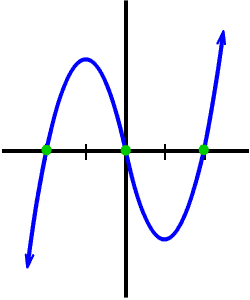JEE-Advanced 2014 (1/40)
If a ∈ R and f : R → R is given by f ( x ) = x 5 − 5 x + a , then which of the followings is/are true?
A.
f
(
x
)
has three real roots if
a
>
4
.
B.
f
(
x
)
has only one real root if
a
>
4
.
C.
f
(
x
)
has three real roots if
a
<
−
4
.
D.
f
(
x
)
has three real roots if
−
4
<
a
<
4
.
This section requires Javascript.
You are seeing this because something didn't load right. We suggest you, (a) try
refreshing the page, (b) enabling javascript if it is disabled on your browser and,
finally, (c)
loading the
non-javascript version of this page
. We're sorry about the hassle.
4 solutions
Let a function be given by g ( x ) = x 5 − 5 x .
When you factorize g ( x ) , you get: g ( x ) = x ( x 2 + 5 ) ( x + 5 ) ( x − 5 )
Hence one can assume from this that g ( x ) has 3 real roots, as x 2 + 5 = 0 has no real roots. The 3 real roots being 0 , 5 and − 5 .
The maximum and minimum values of g ( x ) can be found:
g ′ ( x ) = 5 x 4 − 5 = 5 ( x 2 + 1 ) ( x − 1 ) ( x + 1 ) = 0
x = 1 , − 1
g ( x ) = 1 5 − 5 ( 1 ) = − 4 <-- minimum value of g ( x )
g ( x ) = ( − 1 ) 5 − 5 ( − 1 ) = 4 <-- maximum value of g ( x )
Since the coefficient of x 5 (and taking note that 5 is an odd number) in g ( x ) is positive, and since g ( x ) has 3 real roots, one can imagine g ( x ) to be similar to this image shown:

f ( x ) is similar to g ( x ) , but it is displaced upward or downward (parallel to the y-axis), depending on the value of the constant a .
One can determine that f ( x ) would still have three real roots unless ∣ a ∣ > 4 , and in that case, f ( x ) would only have one real root.
Hence the answer is ( B ) a n d ( D ) .
Hint: Use Intermediate Value Theroem.
Hint: consider g(x)=x^5-5x and plot its graph and then work with options.
Is all about roots, so I took f ( x ) = 0 . This means x 5 = 5 x − a , that, by graph, has an interval of a with 3 solutions, for a ∈ [ − 4 , 4 ] , because y = 5 x − a is tangent for a = − 4 or a = 4 . If a is out of [ − 4 , 4 ] it has only one solution.